How design can change your life
Day one at Cheltenham Design Festival 2014 inspires debate, discussion and change
This weekend Cheltenham Design Festival returned for a third stellar year, bringing together some of the world's leading creative visionaries to explore how great design and original thought can change the way we live - and the Computer Arts crew were there to check it out.
Prefaced by the theme 'design can', a strong message of change gathered momentum during Friday's diverse programme of talks and workshops, which encompassed everything from WikiHouse co-founder Alastair Parvin's bold idea to download your own house to Erik Kessels' "new age of storytelling" and beyond.
Design can_
Also among Friday's speakers were tDR's Ian Anderson, D&AD president Laura Jordan-Bambach, designer Morag Myerscough and Tatty Devine's Harriet Vine.
All took to the stage to deliver inspiring insights into their personal creative journeys. The message, throughout, was clear: design can create change - and change can make a difference.
Here, we bring you Computer Arts' highlights from day one at Cheltenham Design Festival 2014...
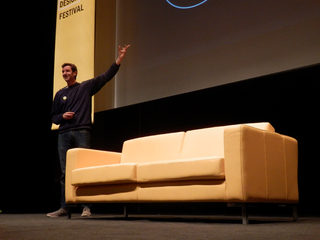
BERG studio founder Jack Schulze kicked off day one in Cheltenham Ladies' College's intimate Parabola Arts Centre auditorium with an entertaining talk about connected systems, looking at how immaterials like Wi-Fi, big data, artificial intelligence and even time are changing the future of design.
Why are connected systems of value? For Schultze, it's about "small chips and the big cloud". He gave the example of a recent Google search for 'pizza', which returned 213,000,000 results in 0.26 seconds.
Get the Creative Bloq Newsletter
Daily design news, reviews, how-tos and more, as picked by the editors.
"The maths in that is comparable to the moon landing," he said. "Today's mobile phones give us all the power of Google in a bit of plastic."
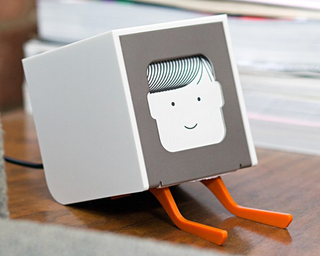
Schultze has built a career - and a forward-thinking studio - from being curious. If you don't know something, he suggested, make your own gear and find out.
"I don't think you can ignore software any more," he added. "But I believe there's plenty of innovation left in the material crafts of design."
Forging new paths
Next on stage in the auditorium, Harriet Vine delivered an inspiring account of how she co-founded cult British accessory brand Tatty Devine with creative partner Rosie Wolfenden.
Since 1999 the pair have been challenging traditional notions of jewellery design with their bold, handmade creations that traverse fashion, design and art - but would the pair have started the business in today's hyper-connected world?
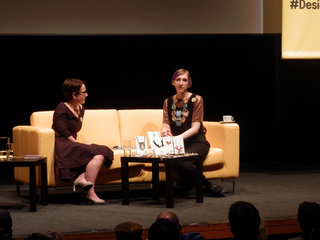
"If we knew everyone on Etsy was making jewellery - well, it's overwhelming," admitted Vine. "The confidence of not knowing that was happening helped us."
Vine's commitment to creativity has taken her on a progressive trajectory: "It goes: things get really hard; you get used to it. Really hard; you get used to it," she explained. "Unless things are challenging, it gets boring."
Changing spaces
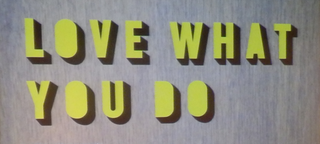
Morag Myerscough specialises in transforming spaces. During her talk, she covered ideas of exploring, belonging, adapting, collaboration and storytelling in an engaging walkthrough of her vibrant portfolio.
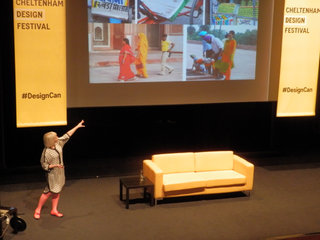
"I want to put the seeds of ideas into things, and then other people take them in new directions," Myerscough explained, talking about the welcoming spaces she creates.
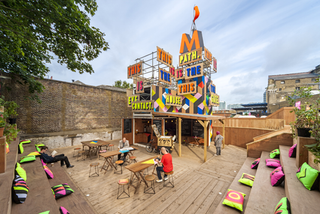
"It's too easy to lose what you're about, or what you're aiming for," Mysercough warned. "You have to enjoy what you do."
Strong ideas
One of Friday's most entertaining sessions in the auditorium came from world renowned creative director and founder of global communications agency KesselsKramer, Erik Kessels.
"Strong ideas allow you to blur," he said, before exploring how progressive brands are increasingly blending traditional and new media to tell their stories. As Kessels demonstrated, his agency excels in communicating messages through surprising methods.
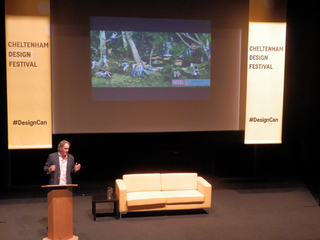
Kessels illustrated his point with a number of striking examples, including a humorous collaboration between KesselsKramer, Stinkdigital director Greg Brunkalla and technology consultancy Hirsch&Mann.
The campaign saw the creatives rig up a selection of products in a London corner shop. Every time a customer selected a Red Stripe from the fridge, the products would start dancing to music.
"We see more images before lunch than someone in the 18 century saw in his whole life," Kessels concluded. Having a good idea, he said, has never been more important.
The way ahead
Later in the afternoon, the BBC's Fi Glover welcomed WikiHouse's Alastair Parvin, D&AD CEO Tim Lindsay, Lord Stevenson of Balmacara and author Peter York on stage for an insightful, probing and occasionally provocative debate on the role of creativity and design in Britain today.
"If you're not quite an evolved person, Britain doesn't make sense," suggested York, who later questioned why the world has Coldplay.
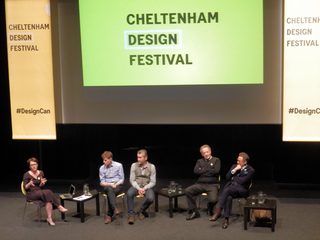
During the panel session, Lindsay discussed the growing lack of diversity in the creative industries. "I'd scrap Trident and use the money to abolish education fees," he said when asked if there was one thing he would change if he could.
Unpaid placements and internships discriminate against those from disadvantaged backgrounds: "It's a self-fulfilling prophecy," he argued.
"Let's fix this thing!" urged D&AD president Laura Bambach-Jordan in a motivational closing session.

Using examples from this year's D&AD White Pencil entries, she showed that it's possible to build meaningful brands in the post-digital world.
"Even in a big organisation where you struggle to see the good, by being someone who wants to create change, you can change a lot," said Jordan-Bambach. "Be the change that changes the industry."
Computer Arts will be bringing you a full event report in issue 227 of the magazine, so stayed tuned.

Thank you for reading 5 articles this month* Join now for unlimited access
Enjoy your first month for just £1 / $1 / €1
*Read 5 free articles per month without a subscription

Join now for unlimited access
Try first month for just £1 / $1 / €1

Julia is editor-in-chief, retail at Future Ltd, where she works in e-commerce across a number of consumer lifestyle brands. A former editor of design website Creative Bloq, she’s also worked on a variety of print titles, and was part of the team that launched consumer tech website TechRadar. She's been writing about art, design and technology for over 15 years.